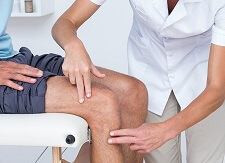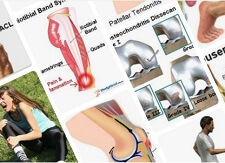- Home
- Knee Pain Treatment
- Rest
Rest Following an Injury
Written By: Chloe Wilson, BSc(Hons) Physiotherapy
Reviewed by: KPE Medical Review Board

After an injury, it is advisable to rest the affected area for a few days to allow it to heal.
Without rest, continual strain is placed on the area, which can lead to increased knee swelling, pain, and in some cases further damage.
There is also a risk of the area not healing properly if it is not allowed time to recover.
How To Rest After Injury
So how much rest is appropriate? Obviously it will depend on the injury, but usually a few days is about right and no longer than a week.
By rest I mean avoiding any activities that increase your pain. Avoid putting too much weight through your knee or stretching it too much. If it hurts, that's often your body's way of saying you are overdoing it. It may mean you need to use crutches or a knee brace for a few days just while things settle down.
When you are sitting down, it really helps to elevate the leg to help reduce any swelling. Inflammation is a common problem after a knee injury and the fluid pools around the joint causing pain and limiting movement. By elevating the leg, it helps the excess fluid to drain away from the knee which helps reduce pain and inflammation and speeds up the healing process. Ideally you want to have the knee higher than your heart for maximum effect. Pillow tend to work better than cushions as they are bigger but the best option is to use a special leg elevation pillow.
But that doesn't mean you should take to your bed! Complete rest can actually be counter productive. It's all about moderation. And you don't go from doing nothing straight back to trying to do everything. Pacing is really important.
Can I Rest Too Much?

YES! It is REALLY important to get moving again after a few days otherwise the muscles start to weaken and the joint stiffens. As things are healing, the right stresses and strains need to be put through the area to help it heal properly.
If a muscle isn't being used at all, it loses 3-5% of its strength every day. Therefore in 3-5 weeks a muscle loses half its strength. You may not initially realise that the area is getting weak as you tend to lose endurance strength first, how long the muscle can keep working for, before instantaneous strength, how strong the muscle is for a short period.
However it takes much longer to get strength back. To increase muscle strength by 10% takes about sixty days.
How Do I Avoid Losing Strength?
You can maintain muscle strength without aggravating an injury with some simple exercises. By tensing the muscle without moving the joint, known as an isometric contraction, for several seconds a day, you can maintain muscle strength.
You don’t have to work the muscle as hard as
you can, you only need to work it at about 20-30% of its maximum (i.e.
think about how hard you could tense the muscle and just do about one third of
that).
Check out the
knee exercise
section for appropriate exercises to do in the early stages following an injury.
What Else Can Help?
This is just one part of the PRICE treatment plan (Protect Rest Ice Compression Elevation). For more ideas on recovering from an injury, visit the knee pain treatment section.
If you want some help working out what is causing your problem, visit the knee pain diagnosis section.
You may also be interested in the following articles:
- Front Knee Pain
- Pain Behind The Knee
- Knee Pain At Night
- Knee Swelling Causes & Treatment
- Home Remedies For Knee Pain
- How To Do Stairs With Knee Pain
- Knee Pain Diagnosis Chart
Page Last Updated: 01/02/24
Next Review Due: 01/02/26






